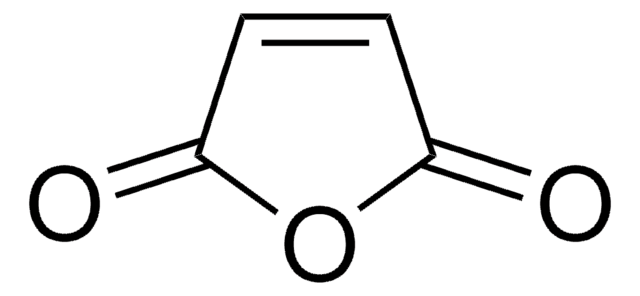912735
Acido maleico
electronic grade, ≥99.97% trace metals basis, water <=350 ppm
Sinonimo/i:
Acido cis-Butenedioico, Acido tosilico
About This Item
Prodotti consigliati
Grado
electronic grade
Livello qualitativo
Saggio
≥99.97% trace metals basis
Stato
powder
Colore
white to off-white
Punto di fusione
130-135 °C (lit.)
Densità
1.59 g/mL at 25 °C (lit.)
Stringa SMILE
OC(=O)\C=C/C(O)=O
InChI
1S/C4H4O4/c5-3(6)1-2-4(7)8/h1-2H,(H,5,6)(H,7,8)/b2-1-
VZCYOOQTPOCHFL-UPHRSURJSA-N
Cerchi prodotti simili? Visita Guida al confronto tra prodotti
Descrizione generale
Applicazioni
Maleic acid has been used in constructing polymeric solid electrolytes for battery and fuel cell. In one study, it was showen that maleic acid based polymer blend helps increasing the ionic conductivity of PEO basd polymer solid electrolytes by suppressing its crystallization.
Maleic acid has also been used to make superswelling acrylamide (AAm)/maleic acid (MA) hydrogels by free radical polymerization in aqueous solution of AAm with MA as comonomer with some multifunctional crosslinkers such as trimethylolpropane triacrylate and 1,4-butanediol dimethacrylate. When the uptake of cationic dye was studied, it was shown that the binding ratio of hydrogel/dye systems was gradually increased with the increase of MA content in the AAm/MA hydrogels.
Avvertenze
Danger
Indicazioni di pericolo
Consigli di prudenza
Classi di pericolo
Acute Tox. 4 Dermal - Acute Tox. 4 Oral - Eye Dam. 1 - Skin Corr. 1 - Skin Sens. 1 - STOT SE 3
Organi bersaglio
Respiratory system
Codice della classe di stoccaggio
8A - Combustible corrosive hazardous materials
Classe di pericolosità dell'acqua (WGK)
WGK 1
Scegli una delle versioni più recenti:
Certificati d'analisi (COA)
Non trovi la versione di tuo interesse?
Se hai bisogno di una versione specifica, puoi cercare il certificato tramite il numero di lotto.
Possiedi già questo prodotto?
I documenti relativi ai prodotti acquistati recentemente sono disponibili nell’Archivio dei documenti.
Il team dei nostri ricercatori vanta grande esperienza in tutte le aree della ricerca quali Life Science, scienza dei materiali, sintesi chimica, cromatografia, discipline analitiche, ecc..
Contatta l'Assistenza Tecnica.



